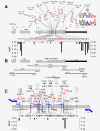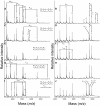Ovine reference materials and assays for prion genetic testing
- PMID: 20433741
- PMCID: PMC2876147
- DOI: 10.1186/1746-6148-6-23
Ovine reference materials and assays for prion genetic testing
Abstract
Background: Genetic predisposition to scrapie in sheep is associated with several variations in the peptide sequence of the prion protein gene (PRNP). DNA-based tests for scoring PRNP codons are essential tools for eradicating scrapie and for evaluating rare alleles for increased resistance to disease. In addition to those associated with scrapie, there are dozens more PRNP polymorphisms that may occur in various flocks. If not accounted for, these sites may cause base-pair mismatching with oligonucleotides used in DNA testing. Thus, the fidelity of scrapie genetic testing is enhanced by knowing the position and frequency of PRNP polymorphisms in targeted flocks.
Results: An adaptive DNA sequencing strategy was developed to determine the 771 bp PRNP coding sequence for any sheep and thereby produce a consensus sequence for targeted flocks. The strategy initially accounted for 43 known polymorphisms and facilitates the detection of unknown polymorphisms through an overlapping amplicon design. The strategy was applied to 953 sheep DNAs from multiple breeds in U.S. populations. The samples included two sets of reference sheep: one set for standardizing PRNP genetic testing and another set for discovering polymorphisms, estimating allele frequencies, and determining haplotype phase. DNA sequencing revealed 16 previously unreported polymorphisms, including a L237P variant on the F141 haplotype. Two mass spectrometry multiplex assays were developed to score five codons of interest in U.S. sheep: 112, 136, 141, 154, and 171. Reference tissues, DNA, trace files, and genotypes from this project are publicly available for use without restriction.
Conclusion: Identifying ovine PRNP polymorphisms in targeted flocks is critical for designing efficient scrapie genetic testing systems. Together with reference DNA panels, this information facilitates training, certification, and development of new tests and knowledge that may expedite the eradication of sheep scrapie.
Figures




Similar articles
-
Linkage disequilibrium across six prion gene regions spanning 20 kbp in U.S. sheep.Mamm Genome. 2006 Nov;17(11):1121-9. doi: 10.1007/s00335-006-0042-6. Epub 2006 Nov 7. Mamm Genome. 2006. PMID: 17091320
-
Characterization of PRNP and SPRN coding regions from atypical scrapie cases diagnosed in Poland.Mol Biol Rep. 2012 Mar;39(3):2575-83. doi: 10.1007/s11033-011-1010-0. Epub 2011 Jun 15. Mol Biol Rep. 2012. PMID: 21674189
-
Prion-like Doppel gene polymorphisms and scrapie susceptibility in Portuguese sheep breeds.Anim Genet. 2010 Jun;41(3):311-4. doi: 10.1111/j.1365-2052.2009.01992.x. Epub 2009 Nov 26. Anim Genet. 2010. PMID: 19968641
-
Influence of the prion protein gene, Prnp, on scrapie susceptibility in sheep.APMIS. 2002 Jan;110(1):33-43. doi: 10.1034/j.1600-0463.2002.100105.x. APMIS. 2002. PMID: 12064254 Review.
-
Review: A review on classical and atypical scrapie in caprine: Prion protein gene polymorphisms and their role in the disease.Animal. 2016 Oct;10(10):1585-93. doi: 10.1017/S1751731116000653. Epub 2016 Apr 25. Animal. 2016. PMID: 27109462 Review.
Cited by
-
Reduced lentivirus susceptibility in sheep with TMEM154 mutations.PLoS Genet. 2012 Jan;8(1):e1002467. doi: 10.1371/journal.pgen.1002467. Epub 2012 Jan 26. PLoS Genet. 2012. PMID: 22291605 Free PMC article.
-
Report of outbreaks of classical scrapie in Dorper sheep and associated prion protein gene polymorphisms in affected flocks.Trop Anim Health Prod. 2015 Aug;47(6):1203-12. doi: 10.1007/s11250-015-0849-9. Epub 2015 May 21. Trop Anim Health Prod. 2015. PMID: 25995150
-
Using whole genome sequence to compare variant callers and breed differences of US sheep.Front Genet. 2023 Jan 4;13:1060882. doi: 10.3389/fgene.2022.1060882. eCollection 2022. Front Genet. 2023. PMID: 36685812 Free PMC article.
-
Genetic testing for TMEM154 mutations associated with lentivirus susceptibility in sheep.PLoS One. 2013;8(2):e55490. doi: 10.1371/journal.pone.0055490. Epub 2013 Feb 11. PLoS One. 2013. PMID: 23408992 Free PMC article.
-
Using sheep genomes from diverse U.S. breeds to identify missense variants in genes affecting fecundity.F1000Res. 2017 Aug 2;6:1303. doi: 10.12688/f1000research.12216.1. eCollection 2017. F1000Res. 2017. PMID: 28928950 Free PMC article.
References
Publication types
MeSH terms
Substances
LinkOut - more resources
Full Text Sources
Medical

